Subtractive Photography – That’s a weird title, yes? Well, I couldn’t quite find the right words to summarize this blog post in to a catchy title that is easily understood. So subtractive photography it is.
I was recently working on a new presentation about simplicity and isolation and that train of thought brought me to this line of thinking that photography can be subtractive in how we mentally assess a scene and then compose it in our camera and decide what needs to be in, or out, of our composition…in the context of the story we want to tell or the emotion we want to convey. When we are photographing landscapes or nature, all the elements are laid out before us and its up to us to decide which of them we want to include in our composition to best achieve our intent and goal for the photograph and we do this by subtracting elements from the scene.
Have you ever noticed how many words people use to convey a thought or tell a story or just pass along information? Have you ever noticed how you react to the amount of words (information) given? When too many words are used, often times it is hard to understand the true essence of what it is someone is trying to say and the listener gets lost and starts to wander mentally. Conversely, if too few words are given, the listener may not understand what the speaker is saying or they don’t understand the point because they just don’t have enough data. The same is true with photography and our compositions. We can use an ultra-wide angle lens and include everything possible in the scene and let the viewer wander around aimlessly until they get bored and move on to something else. Or, we can distill the scene down to so little information that the viewer might not understand what they are looking at or why, so they get frustrated and leave. My perspective on my photography is that I want to say just enough words to tell my visual story without confusing or boring my viewer with too much. I want my subject(story) to be clear and I don’t want anything distracting from that message. I do this my carefully examining everything in my scene and subtracting those things that don’t add to my story; either by removing them completely from the composition or arranging my composition so that they are less visually important or carry less visual weight in the scene, so they don’t distract.
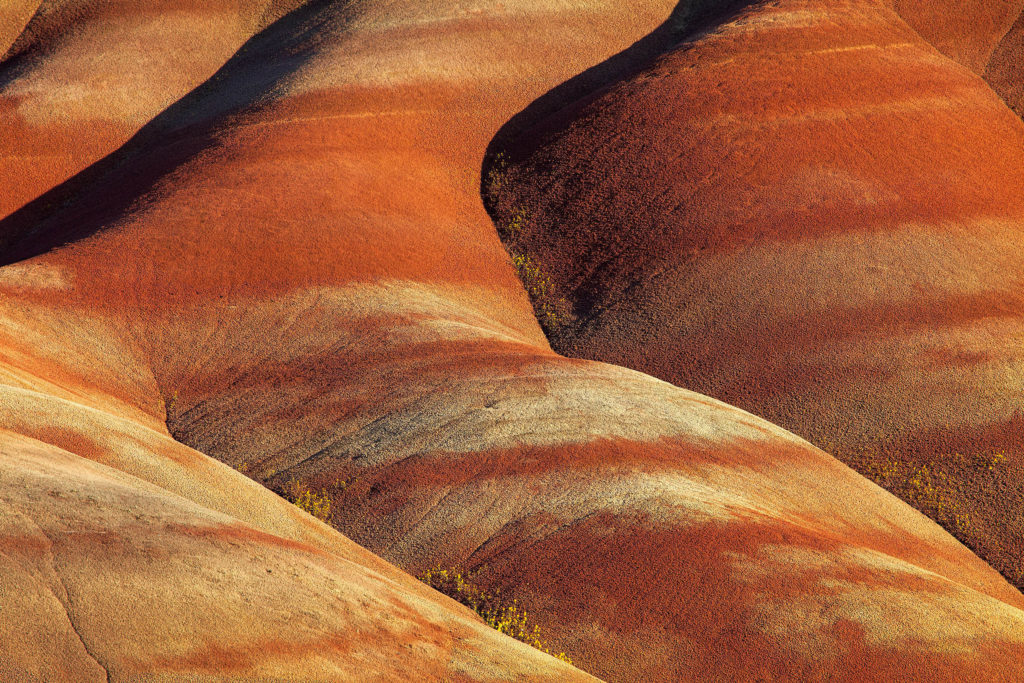
Contrast this with other forms of art, such as painting or pottery. In painting or drawing, the artist starts with a blank canvas and then works to add color and subjects and texture to the artwork. They are practicing “additive” creation and they get to control every element of the scene. Likewise the potter, they start with a lump of clay to form in to a cup or bowl (or in my high school pottery class, an ashtray for mom and dad lol). They can add or subtract clay to get the right size and shape and they may add more pieces of clay to form handles or other elements as part of the creation. Sculptures are essentially the same, the artist is putting together pieces to form a shape with texture and color. You see, many of the other art forms are additive and the artist has complete control over what gets added to the work of art. Stone masons are one of the few other artists that practice subtractive creation, where they remove pieces of stone to form the final shape. There may be other art forms out there, but I hope you get the gist of what I’m getting at.
I often ask my workshop students a simple question when we are out in the field or during image review, “what is the subject?”. You’d be surprised how often that is a hard question to quickly and pointedly answer. Too often there are several subjects in a composition and I’m not sure what the photographer wants me to focus on. Likewise, I may ask “what is the story here, why did you take this photograph?” and again, if they can’t answer this, then I spend some time diving in to why they took it (they will eventually come around to using some words to describe why) and then we’ll talk about how the photograph could have been taken to more clearly express the photographers goal in taking the image.
Not every photograph needs to have a story or be blatantly clear on the subject. Sometimes just taking a “pretty picture” is enough for folks. However, if you are striving to be an artist and create some lasting work, I feel that a photograph needs to have more structure and thoughtfulness applied to it in order to stand the test of time.
So, how do we practice subtractive photography?
First off, find a scene that you are drawn to and want to photograph. Can you identify why you are drawn to this scene? Is it the color, textures, shape, drama, patterns, prettiness, etc? Once you’ve identified why you like a particular scene, then you need to figure what you want to say about it. If you want to really communicate the dramatic waves and water motion along the coastline, great, now you need to find/build a composition that accentuates that as your main subject and remove elements that may distract from your main subject/story and minimize those elements that may be your “supporting cast” in the story. Remember, you haven’t even taken a picture yet, you may not even have your camera out of the bag at this point.
Now comes the work to compose in camera the scene/story that you want to capture. The best ways to compose and practice subtractive photography is using your PHYSICAL LOCATION and LENS CHOICE to compose the scene with the precise amount of elements(words) that you want in your scene to tell the story. Moving your feet, changing your perspective to the subject can radically change the elements in a composition and can help you remove unwanted information. Likewise, switching away from a wide angle lens to a telephoto lens will help you ISOLATE your subject better by narrowing the field of view and what’s included in the composition. Another technique is to change the relative size of your subject/story in the scene, making it larger and thereby clearer to the viewer, so that the other elements in the scene visually recede in importance.
Examples
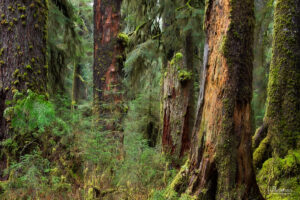
Here is an image from the Hoh Rainforest in Olympic National Park. This is an incredible old forest and there is SO MUCH going on in the forest. Everywhere you turn it is a chaotic jumble of trees, ferns, bushes and everything else found in the forest. How do you make sense of such a visually overwhelming location? By working to isolate and simplify. To distill the scene down to its essence to get the point across.
I was attracted to this stand of trees and wanted to photograph them. The question was, how? I spent at least 10 minutes walking back and forth along the path to find just the right angle where I could get good separation of the tree trunks and not have too much chaos creeping in on the edges of the frame. Then, I chose a medium focal length lens so I could get in tighter to the scene, eliminating some of the distraction of the chaos all around. By using these two techniques, I could achieve what I wanted to do, convey the lushness and crazy growth in this old forest. There’s no doubt what you’re looking at and I wanted to show the green and growth involved in this little slice of the forest.
In this shot along the Oregon coast, I was drawn to the crack in the rock and the anemones living in there and wanted to photograph it. If you’ve ever been to the Oregon coast, you know there is a lot going on along the shore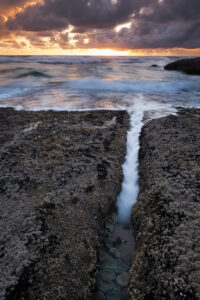 with lots of rock outcroppings going every which way as well as lots of wood, textures, shapes and such that can all creep in to the composition. Because my “story” was about this crack, I wanted to find a way to isolate it as much as possible and distill the scene down to its essence. The sky and the ocean are the supporting cast in this story so I did consciously choose to have them in the scene, but it was really about the crack. What I did was make a choice to 1) eliminate as much as possible the surrounding rock outcroppings with a medium focal length then 2) knowing I couldn’t eliminate them completely, I got down LOW and CLOSE to the crack so I could make it visually larger in the composition and thus such a strong main subject that any distractions would fall by the wayside.
with lots of rock outcroppings going every which way as well as lots of wood, textures, shapes and such that can all creep in to the composition. Because my “story” was about this crack, I wanted to find a way to isolate it as much as possible and distill the scene down to its essence. The sky and the ocean are the supporting cast in this story so I did consciously choose to have them in the scene, but it was really about the crack. What I did was make a choice to 1) eliminate as much as possible the surrounding rock outcroppings with a medium focal length then 2) knowing I couldn’t eliminate them completely, I got down LOW and CLOSE to the crack so I could make it visually larger in the composition and thus such a strong main subject that any distractions would fall by the wayside.
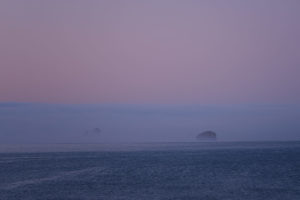 Another technique for subtractive photography is to take advantage of a helping hand from nature. I love photographing during foggy times because it helps to eliminate any distracting elements so I can focus and isolate main subjects. This is a shot from the Southern Oregon coast during one of my workshops and when we came around a bend in the road and the vista opened up to a foggy scene, I had to stop to photograph it. The subject in this scene are the two sea stacks, and the fog provides cover to some lesser rocks in the ocean so I’m just left with those two. Plus, the use of negative space also helps to simplify and add a calming influence to the scene.
Another technique for subtractive photography is to take advantage of a helping hand from nature. I love photographing during foggy times because it helps to eliminate any distracting elements so I can focus and isolate main subjects. This is a shot from the Southern Oregon coast during one of my workshops and when we came around a bend in the road and the vista opened up to a foggy scene, I had to stop to photograph it. The subject in this scene are the two sea stacks, and the fog provides cover to some lesser rocks in the ocean so I’m just left with those two. Plus, the use of negative space also helps to simplify and add a calming influence to the scene.
Here’s the last example of how you can subtract elements from the scene. These two shots were done in a lake on the way to Mt Rainier.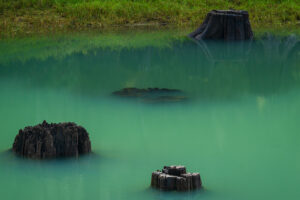 I was captivated by the color of the water and how it contrasted with the texture and history of the stumps that were visible in the water. I was captivated by this scene and wanted to capture it. Here is one of the first shots I composed, showing multiple stumps in the water. What I chose to subtract from the scene was the messy shoreline and forest in the background. I felt that they didn’t add to the story of the tree stumps and green water, which are the subjects of this shot. I didn’t need any wider context to capture my photographic goal.
I was captivated by the color of the water and how it contrasted with the texture and history of the stumps that were visible in the water. I was captivated by this scene and wanted to capture it. Here is one of the first shots I composed, showing multiple stumps in the water. What I chose to subtract from the scene was the messy shoreline and forest in the background. I felt that they didn’t add to the story of the tree stumps and green water, which are the subjects of this shot. I didn’t need any wider context to capture my photographic goal.
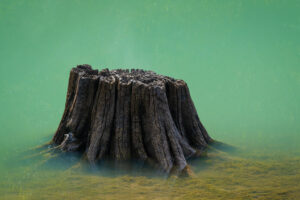 Now taking subtractive photography one step further, I put on my longest telephoto lens and isolated just one stump. My message is still there, of a tree stump in green water. The story has changed a bit though, from a “forest” of stumps to just one stump, which might bring some intrigue and question from the viewer such as “are there more?” Both shots work for me and it’s just a matter of preference which one I might like better.
Now taking subtractive photography one step further, I put on my longest telephoto lens and isolated just one stump. My message is still there, of a tree stump in green water. The story has changed a bit though, from a “forest” of stumps to just one stump, which might bring some intrigue and question from the viewer such as “are there more?” Both shots work for me and it’s just a matter of preference which one I might like better.
Conclusion
As you are out in the field, I challenge you to think about this concept of “subtraction” and removing elements from your composition that don’t support your subject or story. Besides being a fun mental game and a challenge, it also helps to strength and clarify what we are trying to say with our visual art and hopefully make longer lasting images.


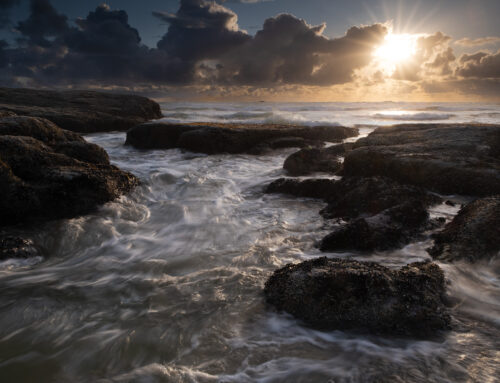
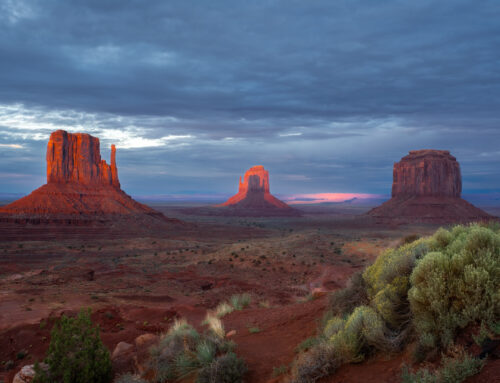
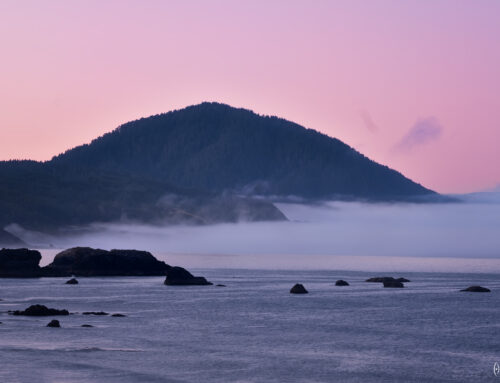
Leave A Comment